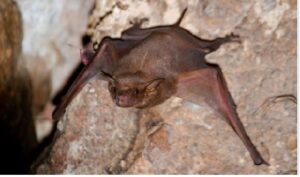Naked-Rumped Tomb Bat or Naked-bellied Tomb Bat
General Description
|

Credit: Rajesh Puttaswamaiah |
- Bats are greyish brown above, and paler below.
- They have strong-smelling glands in throat sacs which may be used in courtship.
- Parts of the belly are naked.
- Fur does not extend to the tail membrane.
- The lower back, abdomen, chin, throat, and cheeks are hairless.
- The short tail protrudes from the midpoint of the membrane.
- The head is fairly flat with a long, cone-shaped snout and a shallow depression between the large eyes.
- The lower lip has a grooved protuberance and the ears are triangular and backward-pointing.
- There is no nose leaf and the throat pouches are well-developed in the male but less so in the female.
- The fur is short and sleek and covers the whole body apart from the rump, lower belly, and hind limbs.
- The dorsal pelage is pale greyish-brown, deep brown, or rusty-brown and the ventral pelage is a paler color than the back.
- The wing membrane is dark brown and the tail projects freely from the upper surface of the interfemoral membrane.
Life Cycle and Common Characteristics
- For most of the year, males and females roost together, but the males move to roost elsewhere before the young are born.
- For the first few weeks, the newborn bat clings to its mother while she flies, but later, the young roost beside their mothers, remaining behind while their mothers forage.
- The gestation period is nine weeks, but the female may store the sperm during hibernation, with fertilization and pregnancy occurring in the spring.
- This bat species is agile, flying fast and high in open areas, hawking for insects.
- It is a social species, becoming active about half an hour before the sun sets, and streaming from the daytime roost shortly after sunset.
- Its diet includes beetles, moths, grasshoppers, crickets, cockroaches, and flying ants.
- It roosts gregariously in crevices between stones, in caves, crags, ruins, and old buildings.
Damages and Medical Implications
- The naked-rumped tomb bat roosts in old ruins, mosques, and wells.




